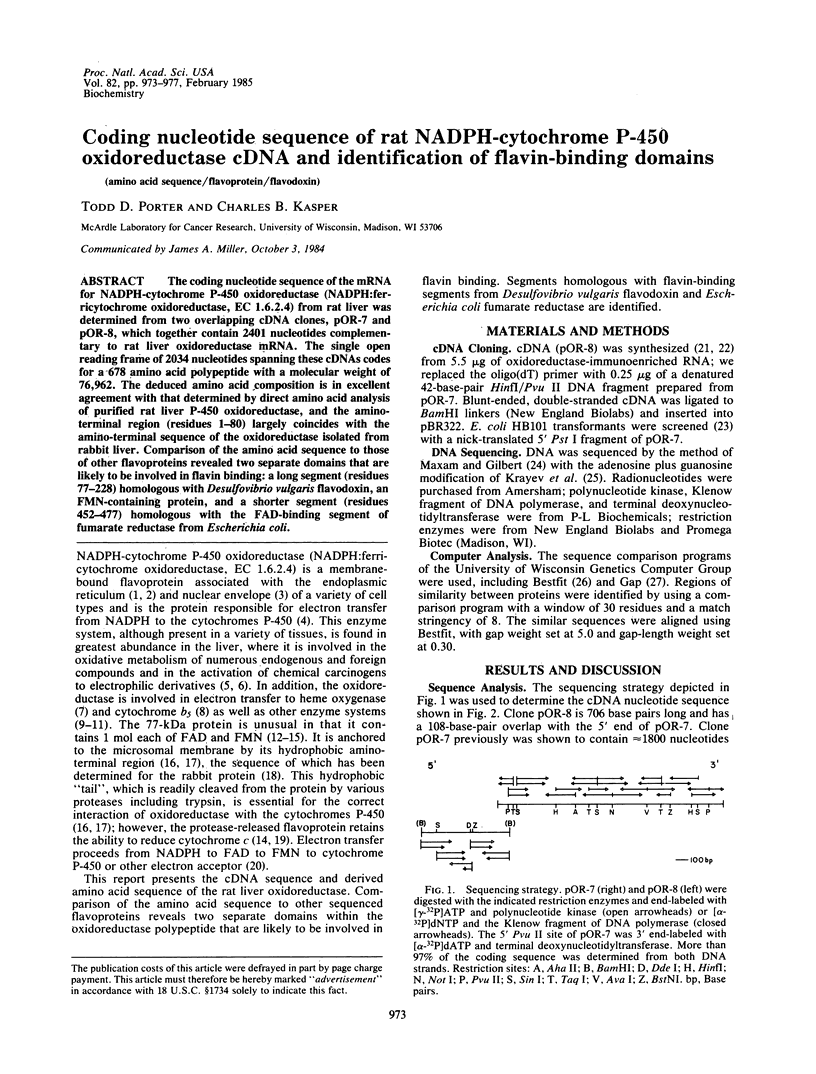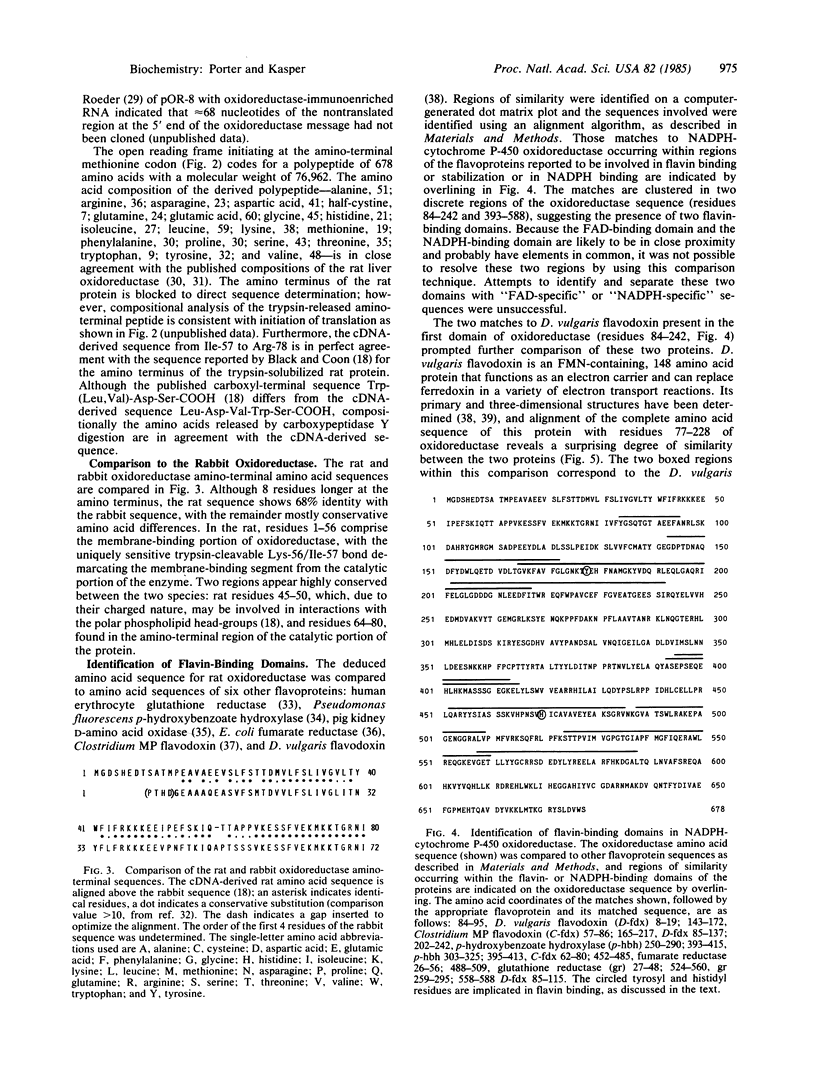Abstract
The coding nucleotide sequence of the mRNA for NADPH-cytochrome P-450 oxidoreductase (NADPH:ferricytochrome oxidoreductase, EC 1.6.2.4) from rat liver was determined from two overlapping cDNA clones, pOR-7 and pOR-8, which together contain 2401 nucleotides complementary to rat liver oxidoreductase mRNA. The single open reading frame of 2034 nucleotides spanning these cDNAs codes for a 678 amino acid polypeptide with a molecular weight of 76,962. The deduced amino acid composition is in excellent agreement with that determined by direct amino acid analysis of purified rat liver P-450 oxidoreductase, and the amino-terminal region (residues 1-80) largely coincides with the amino-terminal sequence of the oxidoreductase isolated from rabbit liver. Comparison of the amino acid sequence to those of other flavoproteins revealed two separate domains that are likely to be involved in flavin binding: a long segment (residues 77-228) homologous with Desulfovibrio vulgaris flavodoxin, an FMN-containing protein, and a shorter segment (residues 452-477) homologous with the FAD-binding segment of fumarate reductase from Escherichia coli.
Full text
PDF




Selected References
These references are in PubMed. This may not be the complete list of references from this article.
- Black S. D., Coon M. J. Structural features of liver microsomal NADPH-cytochrome P-450 reductase. Hydrophobic domain, hydrophilic domain, and connecting region. J Biol Chem. 1982 May 25;257(10):5929–5938. [PubMed] [Google Scholar]
- Black S. D., French J. S., Williams C. H., Jr, Coon M. J. Role of a hydrophobic polypeptide in the N-terminal region of NADPH-cytochrome P-450 reductase in complex formation with P-450LM. Biochem Biophys Res Commun. 1979 Dec 28;91(4):1528–1535. doi: 10.1016/0006-291x(79)91238-5. [DOI] [PubMed] [Google Scholar]
- Cole S. T. Nucleotide sequence coding for the flavoprotein subunit of the fumarate reductase of Escherichia coli. Eur J Biochem. 1982 Mar 1;122(3):479–484. doi: 10.1111/j.1432-1033.1982.tb06462.x. [DOI] [PubMed] [Google Scholar]
- Dignam J. D., Strobel H. W. Preparation of homogeneous NADPH-cytochrome P-450 reductase from rat liver. Biochem Biophys Res Commun. 1975 Apr 21;63(4):845–852. doi: 10.1016/0006-291x(75)90644-0. [DOI] [PubMed] [Google Scholar]
- Dubourdieu M., Fox J. L. Amino acid sequence of Desulfovibrio vulgaris flavodoxin. J Biol Chem. 1977 Feb 25;252(4):1453–1463. [PubMed] [Google Scholar]
- Enoch H. G., Strittmatter P. Cytochrome b5 reduction by NADPH-cytochrome P-450 reductase. J Biol Chem. 1979 Sep 25;254(18):8976–8981. [PubMed] [Google Scholar]
- Fitch W. M., Smith T. F. Optimal sequence alignments. Proc Natl Acad Sci U S A. 1983 Mar;80(5):1382–1386. doi: 10.1073/pnas.80.5.1382. [DOI] [PMC free article] [PubMed] [Google Scholar]
- Gelboin H. V. Benzo[alpha]pyrene metabolism, activation and carcinogenesis: role and regulation of mixed-function oxidases and related enzymes. Physiol Rev. 1980 Oct;60(4):1107–1166. doi: 10.1152/physrev.1980.60.4.1107. [DOI] [PubMed] [Google Scholar]
- Gonzalez F. J., Kasper C. B. Cloning of DNA complementary to rat liver NADPH-cytochrome c (P-450) oxidoreductase and cytochrome P-450b mRNAs. Evidence that phenobarbital augments transcription of specific genes. J Biol Chem. 1982 May 25;257(10):5962–5968. [PubMed] [Google Scholar]
- Gonzalez F. J., Kasper C. B. Cloning of epoxide hydratase complementary DNA. J Biol Chem. 1981 May 25;256(10):4697–4700. [PubMed] [Google Scholar]
- Gum J. R., Strobel H. W. Isolation of the membrane-binding peptide of NADPH-cytochrome P-450 reductase. Characterization of the peptide and its role in the interaction of reductase with cytochrome P-450. J Biol Chem. 1981 Jul 25;256(14):7478–7486. [PubMed] [Google Scholar]
- Gum J. R., Strobel H. W. Purified NADPH cytochrome P-450 reductase. Interaction with hepatic microsomes and phospholipid vesicles. J Biol Chem. 1979 May 25;254(10):4177–4185. [PubMed] [Google Scholar]
- Hardwick J. P., Gonzalez F. J., Kasper C. B. Cloning of DNA complementary to cytochrome P-450 induced by pregnenolone-16 alpha-carbonitrile. Characterization of its mRNA, gene, and induction response. J Biol Chem. 1983 Aug 25;258(16):10182–10186. [PubMed] [Google Scholar]
- Ilan Z., Ilan R., Cinti D. L. Evidence for a new physiological role of hepatic NADPH:ferricytochrome (P-450) oxidoreductase. Direct electron input to the microsomal fatty acid chain elongation system. J Biol Chem. 1981 Oct 10;256(19):10066–10072. [PubMed] [Google Scholar]
- Iyanagi T., Mason H. S. Some properties of hepatic reduced nicotinamide adenine dinucleotide phosphate-cytochrome c reductase. Biochemistry. 1973 Jun 5;12(12):2297–2308. doi: 10.1021/bi00736a018. [DOI] [PubMed] [Google Scholar]
- Kasper C. B. Biochemical distinctions between the nuclear and microsomal membranes from rat hepatocytes. J Biol Chem. 1971 Feb 10;246(3):577–581. [PubMed] [Google Scholar]
- Krauth-Siegel R. L., Blatterspiel R., Saleh M., Schiltz E., Schirmer R. H., Untucht-Grau R. Glutathione reductase from human erythrocytes. The sequences of the NADPH domain and of the interface domain. Eur J Biochem. 1982 Jan;121(2):259–267. doi: 10.1111/j.1432-1033.1982.tb05780.x. [DOI] [PubMed] [Google Scholar]
- Krayev A. S., Kramerov D. A., Skryabin K. G., Ryskov A. P., Bayev A. A., Georgiev G. P. The nucleotide sequence of the ubiquitous repetitive DNA sequence B1 complementary to the most abundant class of mouse fold-back RNA. Nucleic Acids Res. 1980 Mar 25;8(6):1201–1215. doi: 10.1093/nar/8.6.1201. [DOI] [PMC free article] [PubMed] [Google Scholar]
- Lee D. C., Roeder R. G. Transcription of adenovirus type 2 genes in a cell-free system: apparent heterogeneity of initiation at some promoters. Mol Cell Biol. 1981 Jul;1(7):635–651. doi: 10.1128/mcb.1.7.635. [DOI] [PMC free article] [PubMed] [Google Scholar]
- Lu A. Y., Junk K. W., Coon M. J. Resolution of the cytochrome P-450-containing omega-hydroxylation system of liver microsomes into three components. J Biol Chem. 1969 Jul 10;244(13):3714–3721. [PubMed] [Google Scholar]
- Lu A. Y., Junk K. W., Coon M. J. Resolution of the cytochrome P-450-containing omega-hydroxylation system of liver microsomes into three components. J Biol Chem. 1969 Jul 10;244(13):3714–3721. [PubMed] [Google Scholar]
- Master B. S., Prough R. A., Kamin H. Properties of the stable aerobic and anaerobic half-reduced states of NADPH-cytochrome c reductase. Biochemistry. 1975 Feb 11;14(3):607–613. doi: 10.1021/bi00674a022. [DOI] [PubMed] [Google Scholar]
- Masters B. S., Baron J., Taylor W. E., Isaacson E. L., LoSpalluto J. Immunochemical studies on electron transport chains involving cytochrome P-450. I. Effects of antibodies to pig liver microsomal reduced triphosphopyridine nucleotide-cytochrome c reductase and the non-heme iron protein from bovine adrenocortical mitochondria. J Biol Chem. 1971 Jul 10;246(13):4143–4150. [PubMed] [Google Scholar]
- Maxam A. M., Gilbert W. Sequencing end-labeled DNA with base-specific chemical cleavages. Methods Enzymol. 1980;65(1):499–560. doi: 10.1016/s0076-6879(80)65059-9. [DOI] [PubMed] [Google Scholar]
- Needleman S. B., Wunsch C. D. A general method applicable to the search for similarities in the amino acid sequence of two proteins. J Mol Biol. 1970 Mar;48(3):443–453. doi: 10.1016/0022-2836(70)90057-4. [DOI] [PubMed] [Google Scholar]
- Nisimoto Y., Hayashi F., Akutsu H., Kyogoku Y., Shibata Y. Photochemically induced dynamic nuclear polarization study on microsomal NADPH-cytochrome P-450 reductase. J Biol Chem. 1984 Feb 25;259(4):2480–2483. [PubMed] [Google Scholar]
- Ono T., Ozasa S., Hasegawa F., Imai Y. Involvement of NADPH-cytochrome c reductase in the rat liver squalene epoxidase system. Biochim Biophys Acta. 1977 Mar 25;486(3):401–407. [PubMed] [Google Scholar]
- PHILLIPS A. H., LANGDON R. G. Hepatic triphosphopyridine nucleotide-cytochrome c reductase: isolation, characterization, and kinetic studies. J Biol Chem. 1962 Aug;237:2652–2660. [PubMed] [Google Scholar]
- Schacter B. A., Nelson E. B., Marver H. S., Masters B. S. Immunochemical evidence for an association of heme oxygenase with the microsomal electron transport system. J Biol Chem. 1972 Jun 10;247(11):3601–3607. [PubMed] [Google Scholar]
- Staden R. An interactive graphics program for comparing and aligning nucleic acid and amino acid sequences. Nucleic Acids Res. 1982 May 11;10(9):2951–2961. doi: 10.1093/nar/10.9.2951. [DOI] [PMC free article] [PubMed] [Google Scholar]
- Tanaka M., Haniu M., Yasunobu K. T., Yoch D. C. Complete amino acid sequence of azotoflavin, a flavodoxin from Azotobacter vinelandii. Biochemistry. 1977 Aug 9;16(16):3525–3537. doi: 10.1021/bi00635a005. [DOI] [PubMed] [Google Scholar]
- Tanka M., Haniu M., Yasunobu F., Mayhew S. G. The amino acid sequence of the Clostridium MP flavodoxin. J Biol Chem. 1974 Jul 25;249(14):4393–4396. [PubMed] [Google Scholar]
- Thayer R. E. An improved method for detecting foreign DNA in plasmids of Escherichia coli. Anal Biochem. 1979 Sep 15;98(1):60–63. doi: 10.1016/0003-2697(79)90705-x. [DOI] [PubMed] [Google Scholar]
- Vermilion J. L., Ballou D. P., Massey V., Coon M. J. Separate roles for FMN and FAD in catalysis by liver microsomal NADPH-cytochrome P-450 reductase. J Biol Chem. 1981 Jan 10;256(1):266–277. [PubMed] [Google Scholar]
- Vermilion J. L., Coon M. J. Highly purified detergent-solubilized NADPH-cytochrome P-450 reductase from phenobarbital-induced rat liver microsomes. Biochem Biophys Res Commun. 1974 Oct 23;60(4):1315–1322. doi: 10.1016/0006-291x(74)90341-6. [DOI] [PubMed] [Google Scholar]
- Vermilion J. L., Coon M. J. Purified liver microsomal NADPH-cytochrome P-450 reductase. Spectral characterization of oxidation-reduction states. J Biol Chem. 1978 Apr 25;253(8):2694–2704. [PubMed] [Google Scholar]
- WILLIAMS C. H., Jr, KAMIN H. Microsomal triphosphopyridine nucleotide-cytochrome c reductase of liver. J Biol Chem. 1962 Feb;237:587–595. [PubMed] [Google Scholar]
- Watenpaugh K. D., Sieker L. C., Jensen L. H. The binding of riboflavin-5'-phosphate in a flavoprotein: flavodoxin at 2.0-Angstrom resolution. Proc Natl Acad Sci U S A. 1973 Dec;70(12):3857–3860. doi: 10.1073/pnas.70.12.3857. [DOI] [PMC free article] [PubMed] [Google Scholar]
- Weijer W. J., Hofsteenge J., Vereijken J. M., Jekel P. A., Beintema J. J. Primary structure of p-hydroxybenzoate hydroxylase from Pseudomonas fluorescens. Biochim Biophys Acta. 1982 Jun 4;704(2):385–388. doi: 10.1016/0167-4838(82)90170-4. [DOI] [PubMed] [Google Scholar]
- Weiner J. H., Dickie P. Fumarate reductase of Escherichia coli. Elucidation of the covalent-flavin component. J Biol Chem. 1979 Sep 10;254(17):8590–8593. [PubMed] [Google Scholar]


